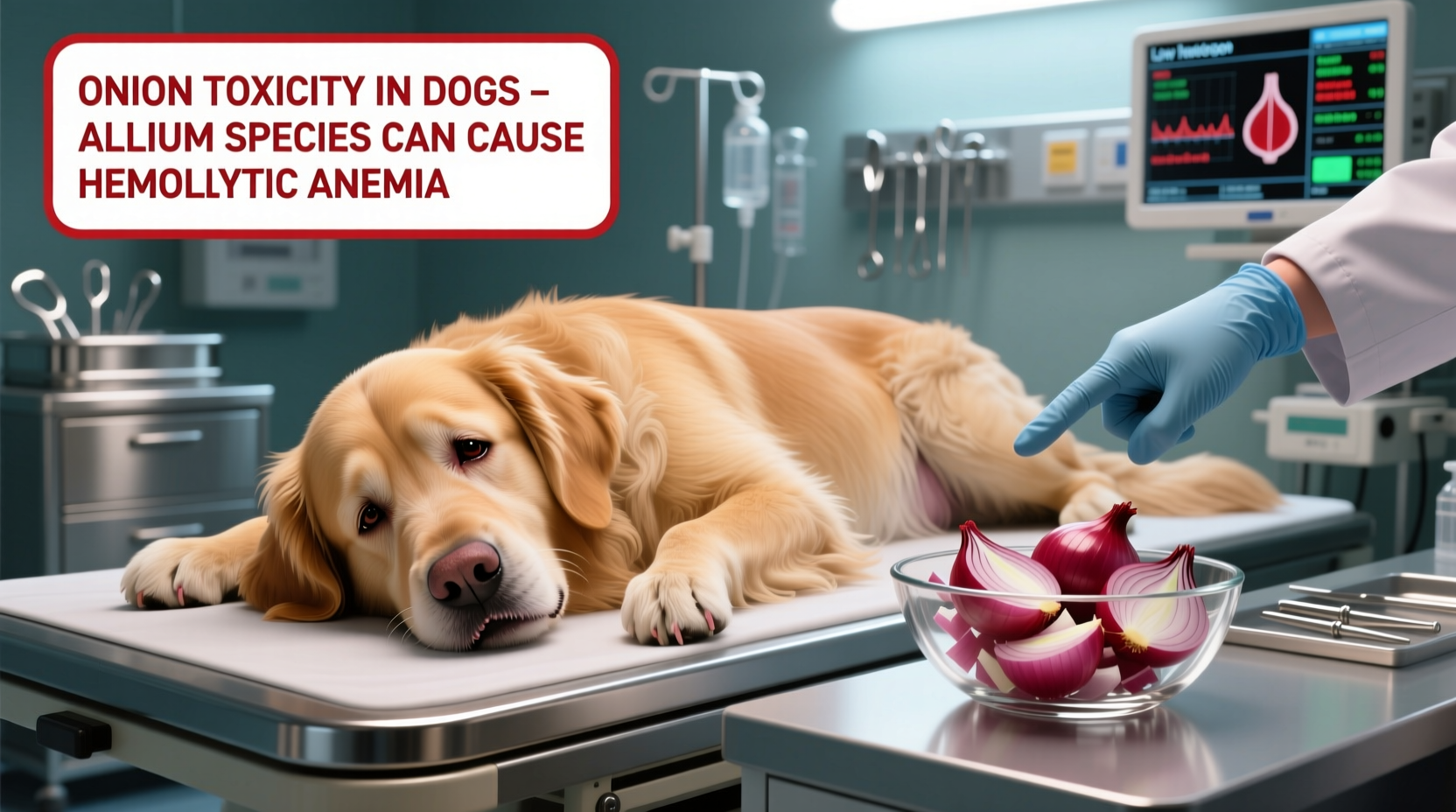Immediate Actions: What to Do If Your Dog Ate Onions
If you suspect your dog ingested onions, garlic, leeks, or chives, take these critical steps within the first hour:
- Contact your veterinarian or animal poison control (ASPCA Animal Poison Control: 888-426-4435) with details about what and how much was consumed
- Do not induce vomiting unless specifically instructed by a professional - improper induction can cause additional complications
- Preserve a sample of the ingested material and any vomit for veterinary analysis
- Monitor breathing and gum color while traveling to the clinic - pale or yellowish gums indicate developing anemia

Understanding Onion Toxicity in Dogs: The Science Behind the Danger
Onions and other Allium family plants (garlic, leeks, chives, shallots) contain N-propyl disulfide and other organosulfur compounds that oxidize hemoglobin in red blood cells. This creates Heinz bodies - damaged areas that make red blood cells fragile and prone to rupture. The resulting hemolytic anemia reduces oxygen delivery throughout the body.
Unlike humans, dogs lack sufficient levels of the enzyme glucuronyl transferase needed to safely process these compounds. This biological difference makes even small amounts potentially dangerous. According to the Merck Veterinary Manual, repeated small exposures can be as dangerous as a single large ingestion due to cumulative effects.
Symptom Timeline: When to Watch for Warning Signs
Onion poisoning symptoms typically develop gradually. Understanding this progression helps owners recognize problems before they become critical:
| Time After Ingestion | Early Warning Signs | Advanced Symptoms |
|---|---|---|
| 6-24 hours | Mild lethargy, decreased appetite | Rarely present this early |
| 24-72 hours | Increased thirst, mild weakness | Pale gums, rapid breathing |
| 3-5 days | Noticeable lethargy | Dark urine (hemoglobinuria), jaundice, collapse |
Japanese breeds like Shiba Inus and Akitas show heightened sensitivity to onion toxicity due to genetic factors affecting red blood cell structure, according to research published in the American Journal of Veterinary Research.
Toxic Dose Guidelines: How Much Is Dangerous?
The toxic threshold varies by dog size and individual sensitivity, but veterinary toxicologists generally consider:
- Minimum toxic dose: 5g of onion per kg of body weight (about 0.5% of body weight)
- Moderate risk: 15-30g per kg (equivalent to 1-2 tablespoons of onion powder for a 30lb dog)
- Severe risk: 30g+ per kg (a medium onion for a small dog)
Garlic is approximately 5 times more potent than onions. The ASPCA Animal Poison Control Center reports that as little as one clove of garlic can cause problems in small dogs.
Veterinary Treatment Protocols
If your dog requires professional care for onion poisoning, veterinarians typically follow this evidence-based approach:
- Decontamination: Activated charcoal administration within 2-4 hours of ingestion to absorb remaining toxins
- Supportive care: Intravenous fluids to maintain hydration and support kidney function
- Oxygen therapy: For dogs showing significant anemia (packed cell volume below 20%)
- Blood transfusion: In severe cases where red blood cell count drops dangerously low
- Monitoring: Serial blood tests to track red blood cell recovery over 7-14 days
Prognosis is generally good with prompt treatment, but delayed intervention can lead to permanent organ damage or death. The Veterinary Partner reports that dogs treated within 12 hours of ingestion typically recover fully within 2-3 weeks.
Prevention Strategies Every Dog Owner Should Know
Preventing onion exposure requires vigilance in these often-overlooked areas:
- Human food hazards: Avoid sharing table scraps containing onions, garlic, or onion powder (common in gravies, sauces, and processed foods)
- Leftover dangers: Securely store cooking scraps - dogs often raid trash cans containing onion peels or food remnants
- Home-cooked meals: Never add onions or garlic to dog food recipes, even in small "healthy" amounts
- Garden safety: Prevent access to growing onion, garlic, or chive plants in your yard
- Read labels: Check commercial dog foods and treats for onion or garlic powder (sometimes listed as "seasoning" or "natural flavors")
When cooking for your dog, use safe flavor alternatives like small amounts of parsley, basil, or oregano. The American Kennel Club confirms these herbs provide flavor without the toxic risk associated with Allium plants.
Frequently Asked Questions
Can dogs recover from onion poisoning?
Yes, dogs can fully recover from onion poisoning with prompt veterinary treatment. Recovery typically takes 2-3 weeks as the body replaces damaged red blood cells. The prognosis depends on the amount ingested and how quickly treatment begins - dogs treated within 12 hours generally have excellent outcomes.
How long after eating onions will a dog show symptoms?
Symptoms typically appear 1-5 days after ingestion, with most dogs showing signs within 24-72 hours. Initial symptoms include lethargy and decreased appetite, progressing to pale gums, rapid breathing, and dark urine as anemia develops. Delayed symptom onset makes early intervention critical.
Is cooked onion still toxic to dogs?
Yes, cooking does not reduce onion toxicity. All forms - raw, cooked, powdered, or dehydrated - remain dangerous to dogs. Onion powder is particularly hazardous as it concentrates the toxic compounds. Even small amounts in soups, gravies, or baby food can cause poisoning.
Which dog breeds are most sensitive to onion poisoning?
Japanese breeds including Shiba Inus and Akitas show heightened sensitivity due to genetic factors affecting red blood cell structure. However, all dog breeds are susceptible to onion toxicity. Small dogs face greater risk from smaller quantities due to their size, but even large breeds can develop severe anemia from significant exposures.











 浙公网安备
33010002000092号
浙公网安备
33010002000092号 浙B2-20120091-4
浙B2-20120091-4